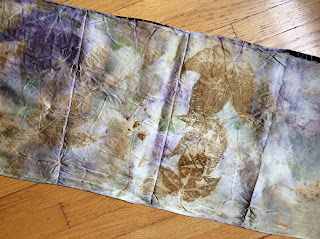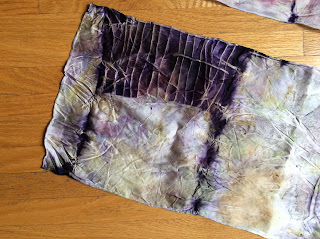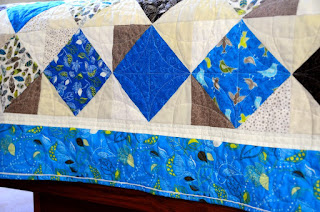In addition to the ecoprinted scarves, I also tried dyeing some larger pieces of cotton and linen-cotton mix PFD fabric. I ecoprinted with various leaves, and I also dyed some solids, all with logwood. This time I let the bundles sit a good four days or so before checking the results. Now I have the beginnings of a quilt on my design wall:
This was back in November, and as the weather got colder and more and more leaves dropped from the trees, I thought I was done for the season. One day, however, I was walking in the neighborhood, and I saw a smoke tree in which the late season growth had produced enormous leaves. At the October dye night with India Flint, one of the participants had mentioned to me that leaves from smoke trees made good prints. I knew I had one more silk scarf blank at home, so I couldn't resist gathering some leaves and conducting one more experiment. I made sure to dye my silk bundle just before an out of town trip, so that I wouldn't be tempted to open it prematurely. Instead, it sat for more than a week, and the results were fantastic:
I laid the leaves onto half the scarf, folded the other half over, and rolled it all up. Luckily, the ends were on the outside of the bundle, which meant that they took up more dye, and the string lines made a nice pattern, as shown in the first photo. I rolled the bundle around a piece of PVC pipe in order to maximize contact between the leaves and the silk, as well as to minimize wrinkles and achieve more consistent results. It was thrilling to see how beautifully the leaves printed. The remains of the original leaves were like tissue paper in the end, which also suggested just how well the pigments from the leaves transferred to the fabric.
I made just one error: the printing on the PVC pipe also transferred to the fabric. D'oh!
Fortunately, the numbers are on the back side and right in the center, so they're at the back of my neck when I wear the scarf. Next time I'll make sure there's a layer of scrap fabric between the pipe and the silk.
I hope I'll be able to report progress on the quilt over the next few months. I'm planning to use some of the silk scarves from my previous round of dyeing, in addition to the cottons and linen-cotton mix fabrics. I need to interface the silk, and then I can start playing with it.
Happy holidays, and happy sewing!
This was back in November, and as the weather got colder and more and more leaves dropped from the trees, I thought I was done for the season. One day, however, I was walking in the neighborhood, and I saw a smoke tree in which the late season growth had produced enormous leaves. At the October dye night with India Flint, one of the participants had mentioned to me that leaves from smoke trees made good prints. I knew I had one more silk scarf blank at home, so I couldn't resist gathering some leaves and conducting one more experiment. I made sure to dye my silk bundle just before an out of town trip, so that I wouldn't be tempted to open it prematurely. Instead, it sat for more than a week, and the results were fantastic:
I laid the leaves onto half the scarf, folded the other half over, and rolled it all up. Luckily, the ends were on the outside of the bundle, which meant that they took up more dye, and the string lines made a nice pattern, as shown in the first photo. I rolled the bundle around a piece of PVC pipe in order to maximize contact between the leaves and the silk, as well as to minimize wrinkles and achieve more consistent results. It was thrilling to see how beautifully the leaves printed. The remains of the original leaves were like tissue paper in the end, which also suggested just how well the pigments from the leaves transferred to the fabric.
I made just one error: the printing on the PVC pipe also transferred to the fabric. D'oh!
Fortunately, the numbers are on the back side and right in the center, so they're at the back of my neck when I wear the scarf. Next time I'll make sure there's a layer of scrap fabric between the pipe and the silk.
I hope I'll be able to report progress on the quilt over the next few months. I'm planning to use some of the silk scarves from my previous round of dyeing, in addition to the cottons and linen-cotton mix fabrics. I need to interface the silk, and then I can start playing with it.
Happy holidays, and happy sewing!































